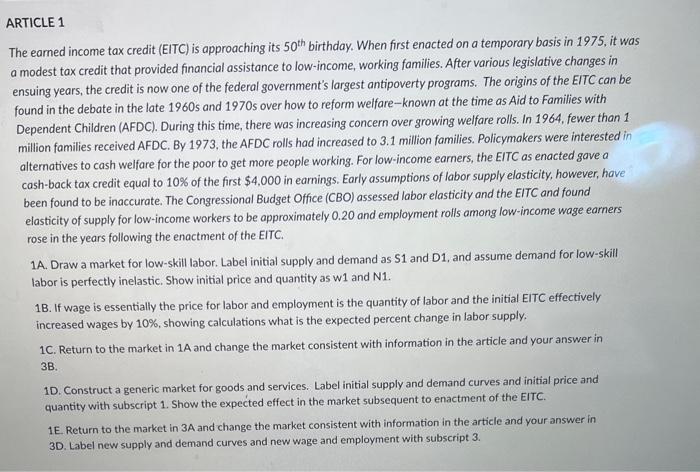The earned income tax credit (EITC) is approaching its 50th birthday. When first enacted on a temporary basis in 1975, it was modest tax credit that provided financial assistance to low-income, working families. After various legislative changes in ensuing years, the credit is now one of the federal government's largest antipoverty programs. The origin s of the EITC can be found in the debate in the late 1960s and 1970 s over how to reform welfare-known at the time as Aid to Families with Dependent Children (AFDC). During this time, there was increasing concern over growing welfare rolls. In 1964, fewer than 1 million families received AFDC. By 1973, the AFDC rolls had increased to 3.1 million families. Policymakers were interested in alternatives to cash welfare for the poor to get more people working. For low-income earners, the EITC as enacted gove a cash-back tax credit equal to 10% of the first $4,000 in earnings. Early assumptions of labor supply elasticity, however, have been found to be inaccurate. The Congressional Budget Office (CBO) assessed labor elasticity and the EITC and found elasticity of supply for low-income workers to be approximately 0.20 and employment rolls among low-income wage earners rose in the years following the enactment of the EITC. 1A. Draw a market for low-skill labor. Label initial supply and demand as $1 and D1, and assume demand for low-skill labor is perfectly inelastic. Show initial price and quantity as w1 and N1. 1B. If wage is essentially the price for labor and employment is the quantity of labor and the initial EITC effectively increased wages by 10%, showing calculations what is the expected percent change in labor supply. 1C. Return to the market in 1A and change the market consistent with information in the article and your answer in 3B. 1D. Construct a generic market for goods and services. Label initial supply and demand curves and initial price and quantity with subscript 1 . Show the expected effect in the market subsequent to enactment of the EITC. 1E. Return to the market in 3A and change the market consistent with information in the article and your answer in 3D. Label new supply and demand curves and new wage and employment with subscript 3. The earned income tax credit (EITC) is approaching its 50th birthday. When first enacted on a temporary basis in 1975, it was modest tax credit that provided financial assistance to low-income, working families. After various legislative changes in ensuing years, the credit is now one of the federal government's largest antipoverty programs. The origin s of the EITC can be found in the debate in the late 1960s and 1970 s over how to reform welfare-known at the time as Aid to Families with Dependent Children (AFDC). During this time, there was increasing concern over growing welfare rolls. In 1964, fewer than 1 million families received AFDC. By 1973, the AFDC rolls had increased to 3.1 million families. Policymakers were interested in alternatives to cash welfare for the poor to get more people working. For low-income earners, the EITC as enacted gove a cash-back tax credit equal to 10% of the first $4,000 in earnings. Early assumptions of labor supply elasticity, however, have been found to be inaccurate. The Congressional Budget Office (CBO) assessed labor elasticity and the EITC and found elasticity of supply for low-income workers to be approximately 0.20 and employment rolls among low-income wage earners rose in the years following the enactment of the EITC. 1A. Draw a market for low-skill labor. Label initial supply and demand as $1 and D1, and assume demand for low-skill labor is perfectly inelastic. Show initial price and quantity as w1 and N1. 1B. If wage is essentially the price for labor and employment is the quantity of labor and the initial EITC effectively increased wages by 10%, showing calculations what is the expected percent change in labor supply. 1C. Return to the market in 1A and change the market consistent with information in the article and your answer in 3B. 1D. Construct a generic market for goods and services. Label initial supply and demand curves and initial price and quantity with subscript 1 . Show the expected effect in the market subsequent to enactment of the EITC. 1E. Return to the market in 3A and change the market consistent with information in the article and your answer in 3D. Label new supply and demand curves and new wage and employment with subscript 3







